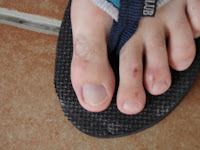
In our guidebook for Panama, each section describes a town or region, and each of these sections contain several standard headings such as ¨where to eat¨, ¨where to sleep¨, ¨local festivals and holidays¨, and, my personal favourite, ¨dangers and annoyances¨. What an excellent name for a section in a travel guide! Dangers and Annoyances!
For this posting of FFDH, we are stealing their section name, and bringing you some of our favourite Panamanian Dangers and Annoyances.
 Annoyance: Jungle Rot.
Annoyance: Jungle Rot.It never really dries out here. EVER. You thought Houston was humid? Try Panama. This picture is of our black backpack that was sitting in the corner of our room. It is covered in a dusty white mildew. Mold is growning on my backpack! That is just so wrong.
Danger: Malaria
Malaria is a nasty disease that is transmitted by mosquitos, aka a vector born protozoan parasite. The anopheles mosquito bites an infected person, and now the mosquito is carrying the malaria bug. This mosquito then bites an uninfected person, and voila! The person is now infected! The parasites multiply within the red blood cells and cause horrible flu-like symptoms that could worsen into a coma and then death.
As described by David McCulough in his awesome history of the making of the Panama Canal, _The Path Between the Seas_, ¨Malaria, the most common of tropical diseases and the one endemic diseas at Panama, takes many forms and went by many differnt names on the Isthmus: calentura, miasma, the chills, paludisme, ague, pernicious fever, putrid fever, intermittent fever, and in its virulent form, Chagres fever.
"Historcally, malaria was the world´s greates killer and it was confined to no one geographical area. . . .there had been a serious epidemic in New England. But in places such as Panam, malaria never went away. . .The typical malarial attack began with terrible chills, uncontrollable shivering, and chattering teeth, the spell lasting perhaps fifteen minutes, sometimes more. Often the shivering of the patients in a malaria ward would be so violent that the room could actually be felt to tremble; a single bed would move on the floor.
¨The chills would be followed by a high fever and burning thirst. As the fever fell off, the patient would break out in a drenching sweat. For those who survived, the experience was unforgettable.
¨There is no such thing as an immunity to malaria¨(pp139).
We are taking anti-malarial drugs. Go science! Go modern medicine!
Annoyance: Bruises on legs.
Where do they come from? Who knows. -But they sure are common.


Danger: Yellow Fever
Yellow Fever is another really nasty tropical disease. It is a virus, also transmitted via mosquitos. The mosquito bites an infected person, carries the nasty virus around in their yucky little mosquito body, then passes it on to the next person they bite.
Here is another wonderful passage from my light vacation reading, _Path Between the Seas_ by McCullough:
¨. . .in the tropics, malaria was taken as an inevitable fact of life, part of teh landscape. Yellow fever, by contrast, came and went in vicious waves. . .wherever or whenver it struck, it spreat panic of a kind that could all but paralyze a community. It was a far more violent and hideaous thing to see; a gruesome way to die.
" As with malaria, the patient was seized first by fits of shivering, high fever, and insatiable thirst. But there wer savage headaches as well, and severe pains in teh back and the legs. The patient would become desperately restless. Then, in another day or so, the trouble would appear to subside and the patient would begin to turn yellow, noticeably in the face and in the eyes.
"In the terminal stages the patient would spit up mouthfuls of dark blood- the infamous, terrifying vomito negro, black vomit. The end usually came swiftly after that. The body temperature would drop, the pulse fade. THe flesh would become cold to the touch. Then, as a rule, in about eight to ten hours, the patient would die"(pp 140).
We got our yellow fever immunization before we left Texas.
Annoyance: Surf bruises

This awesome bruise is on our awesome friend, Kirstie. Yes, she is making super-model face.
The photo, sadly, is quite blurry, but you can still see some nice blue and purple bruise action. Seriously, check out that amazing bruise on the inside of her left upper arm. That is not a shadow! Brilliant!! She wins the Best Bruise In Show award.
Annoyance: Herds of surfer dudes. All attitude, no manners.
Danger: Abrasions from the reef that are slow to heal

These are some really nice cuts and scrapes from bumping into rocks when trying to get out of the surf on rough days, or bumping coral when snorkeling. I advise against both those things. For some reason, these abrasions are really slow to heal here.

As an important aside, Jenny K gets a trophy from us for the best going away present EVER. She sent us on our way with 2 packages of waterproof bandaids, and a tube of neosporin. If I had to choose between my toothbrush, and my bandaids and neosporin, I would really really have a hard time deciding.
Annoyance: Surfboard Rash

 Apparently, dudes with hairy chests get all rashy from the wax on the surfboard tangling up in their manly man hair. I, fortunately, don´t have that problem. I think Ian will end up with calluses by the end of the trip. Gross.
Apparently, dudes with hairy chests get all rashy from the wax on the surfboard tangling up in their manly man hair. I, fortunately, don´t have that problem. I think Ian will end up with calluses by the end of the trip. Gross. Danger: Leishmaniasis
This one is a totally gross flesh eating parasite contracted the bite of the sand fly. Wikepedia has an awesome leish page you should check out. It is actually not terribly uncommon here.
We are all about the bug spray, and staying away from sand flies.
The tropics are fascinating, because unlike most of the US, it is not the elements that will do in the careless, it is the microbes. The diseases and microbes and crazy gross pathogens are what take people out.
Sweet dreams!
Our next post is all about the plants and animals we are seeing here.




Sweet Ian should shave those sexy man hairs.
ReplyDelete